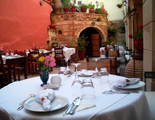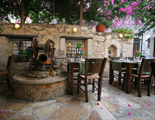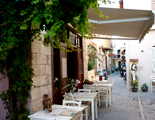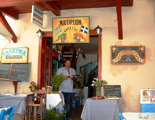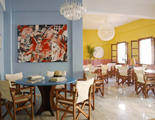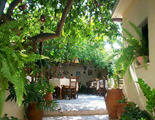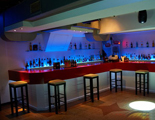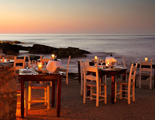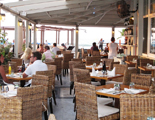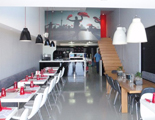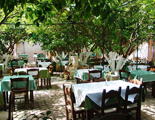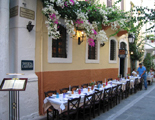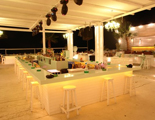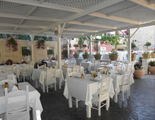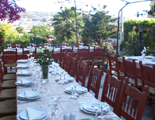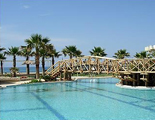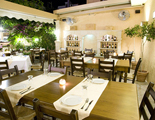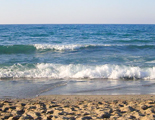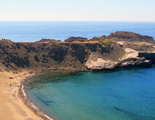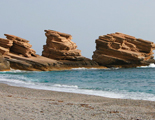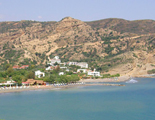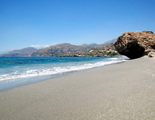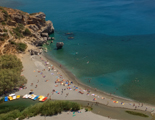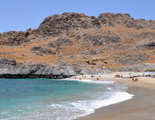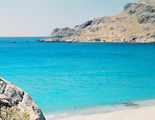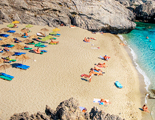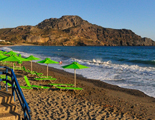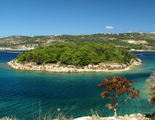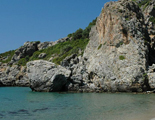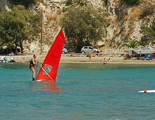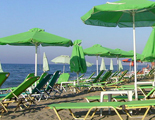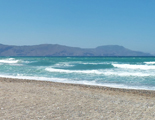 Rethymno Travel Guide
Rethymno Travel Guide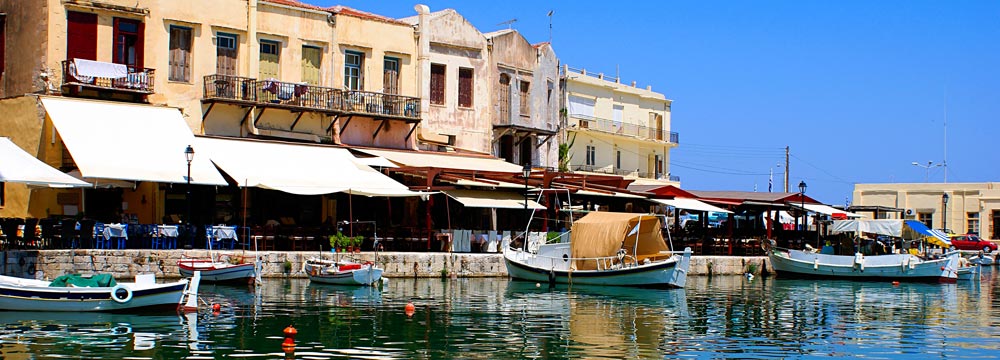
A very strange version of the name ‘Arsinoe’ was used for the city’s name in ancient years and in some myths.
The name Rithymna, Reithimna or Reithemnos is pre-Hellenic and mentioned in almost all the silver and copper coins of the ancient town for the 4th and 3rd BC centuries.
During the Venetian Period, Rethymno is named in various sources as Rethemno, Retimo, Rettimo, Retemo and Rehimo. Since then (1210 AD), the starting letters Re dominate upon the Ri in the first syllabi. Under the Turkish occupation the name remains the same, while the Turks use also the name Ressimo and the inhabitants Ressimi. The official name during the period 1646-1898 was initially Rethymni and later Rethymnon.
After the Turkish occupation, the locals called their city just as in the Venetian period: Rethemnos. Common names were: Rethemno, Rethemnos and the contemporary Rethymno.
According to the Legislative Decree of 1946-7, the town is officially named Rethymnon.
Archaeological findings show that Rethymno welcomed in the later years of the Neolithic period (3500-2800 BC) its first populations. An extended human activity is spread also during the Minoan period (2800-1100 BC) in combination with the appearance of settlements and large building complexes. The area of Eleftherna and Axos show evidence of civilization and great property during the Geometric and Deadalic era (1110-620 BC). These areas continue to grow with works of enormous artistic value into the Archaic period (620-500 BC).
The ancient town of Rithimna, the predecessor of today's Rethymno, flourished during the Classical (500-330 BC) and Hellenistic periods (330-67 BC), while other towns such as Eleftherna, Axos, Lappa and Sivrytos continued to exist till the Greek-Roman period (67 BC - AD 323). Lappa appears as the city with the largest influence in the whole prefecture.
In the Early Byzantine period (330-824), Rethymno came under the control of the Eastern Roman Empire. Christianity begun to spread and, as a result, many churches were built. Continuous Arab invasions disrupted Crete until it was finally conquered in 821. Over the period AD 824-961, the town remained under the Arab rule. 150 years later the Byzantines succeeded the re-conquest of the area and Rethymno passed another 150 years under Byzantine rule. The first fortification of the town was built in this second Byzantine period (961-1210).
Between 1204A.D. and1669 A.D. Crete was under Venetian rule, a period of remarkable growth, especially during the last centuries when the Venetians used Rethymno as an intermediate commercial station between Chania and Heraklion. It was a long but remarkable era which clearly left its marks in the town up today. Rethymno was the third largest town on Crete and an important number of monuments of that time have been preserved.
In the third quarter of the 16th century, the town begun to adopt a Renaissance character according to the Venetian standards: "Fortezza", the fortress built in 1570 to protect the city and its population from the Ottoman threat, “Loggia”, a Noblemen’s Club and the most characteristic Renaissance monument of Rethymno, “Rimondi Fountain”, built by Rimondi, a governor of the area of this time which was rebuilt in 1626 on the ruins of an earlier one and “Saint Franciscus Church”, the church of a Franciscan monastery.
Under the Turkish occupation Rethymno suffered a dark period for three centuries starting from November1646. In 1770 the revolution of Sfakia prepared the grounds for the national Revolution of 1821, which in turn sparked off the events of 1866. By that time, Arkadi Monastery became worldwide known for the mass-death of its defenders. Even after those events, Rethymno remained under the Turkish rule, which led to a new revolution in 1878 resulting in several political and religious privileges to the inhabitants. Eventually,1897 was the last year of the Turkish occupation. The Nerantzes Mosque , the Kara Moussa Mosque , the Great Door Mosque , the Veli Passa Mosque are reminders of the Turkish occupation era.
In 1898, Russian troops disembarked and settled on the island. In the same year, Crete became an autonomous state with its own Constitution and Government till the 1st of December 1913, the day on which Crete was finally unified with the rest of Greece.
In May 1941 Rethymno was one of the German parachutists' three fronts. The memorable resistance of the local people in the battle of Rethymno led to the execution of hundreds of inhabitants and the leveling of entire villages. From 1941 till 1944 people took forceful action against the Germans throughout the entire prefecture, till it was finally liberated like the rest of Greece.
In the prefecture of Rethymno two are the main areas which are connected with the Cretan Mythology. Ideon Andron, a cave at the plateau Nida of mountain Psiloritis, situated in a distance of 78 km east from Rethymno town, and the Talean mountains, named today as Kouloukonas, in the northeast side of the prefecture.
Without doubt the most-known myth is the one which is associated with Zeus’s birth. According to this myth, King Cronus swallowed his children because of his fear that one of them would have the power to take the throne from him in the future. Rhea, his wife, after losing five children, refuge from her furious husband, found shelter in the holy cave of Ideon Andron and gave birth to Zeus. This cave meant to be one of the most important religious centers of the ancient world. Zeus grew up in this cave under the protection of the mythic daemons Kourites, who danced wildly and hit their shields to cover with the sound the baby’s cries, the care of simple shepherds and goat Amalthia, who gave him her milk, and the attention of the nymph Melissa.
Another myth says that King Minos had an appointment with his father Zeus every nine years in Ideon Andron, when the orbits of Sun and Moon converged, in order to collect the new laws. No coincidence that Minos symbolizes the ultimate justice and, therefore, he became a judge in the other world when he died.
A not so widely-known myth mentions that Minos was born in the same cave where his father Zeus was born. When Zeus, transformed into a Taurus, steeled Europe, princess of Finiki (today’s Lebanon area), he brought her in Ideon Andron and uncovered his real face. Their intimate encounter brought Minos, Rhadamanthos and Sarpidonas into life.
The legendary giant Talos is another mythic figure connected with Rethymnon’s mythology. He was the first robot in history, a giant with a Taurus-head, made of copper by Zeus himself. He lived in the cave of Melidoni, a village that still exists today and three times a day he left his cave to protect the sea fronts from enemies. He was also the beholder of the laws. It was the beauty of Medea that made him weak when she arrived on the Argous ship. She removed the nail from his ankles, spilled his blood and Talos died. The Talean mountains are named after him.
Another famous myth is the one of Vassilios Digenes Akritas. The whole area of the municipality of Mylopotamos in Rethymno is connected with the myths and sagas of his activity. He was one of the Akrites, the guards of the Byzantine boarders and his nickname Digenis origins from his descent: his mother was a daughter of a byzantine General, and his father an emir from Syria. The name history of Koutsotroulis, a mountain in Rethymno whose name in the Cretan dialect means “without a peak”, has two versions. In the first, Digenes has such a force during a battle against the enemies that he cuts with his hands the peak of the mountain. Before arriving at the village Makaria, in the area of Gagles, one can see on the top of a large stone a footstep which is supposed to be from Digenes. In the second, the mountain peak collapses, not strong enough to handle Digenes death.
Rethymno is a Venetian inspired town with a Greek soul. The old town, built on the site of ancient Rithymna and part of the ancient site of the Minoan civilization, is one of the best preserved towns of the Renaissance period. Lying in the heart of the modern city, it combines the oriental features of the Turkish period with Renaissance and Venetian style architecture. The monumental aristocratic elements of the past are harmonically combined with the modern architectural point of view creating a unique atmosphere. The Great Gate, the Mosques, the Rimondi Fountain, the Venetian Loggia, the Fortezza, the small Venetian harbor are wonderful remnants of past periods and the unique charm of the old town which, in coexistence with the modern shops, cafes and restaurants, forms a magical picture.
Fortezza is the fortress of Rethymno Town and its walls are about 1,3 km long. Untouched by the passing of time, it is the most impressive building, built on a hill overlooking the port and the entire settlement. Fortezza was a classic fortress completely organized with residences, barracks, deposits and shelters. It was constructed in order to protect Rethymno from enemy attacks. Whether you choose the fortress for a day walk or for a romantic sunset gazing, it is surely one of the most remarkable attractions that should not be missed.
The Archeological Museum, the Ecclesiastic Museum, the Historic-Folkloric Museum the Marine Museum and the Centre of Contemporary Art attract many visitors each year with their exhibits of various findings and collections from the past and even present daily life of the Rethymnians. The Administration of Rethymno Prefecture is constantly organizing actions to stimulate the interest in the research and study of Cretan history, art and tradition.
The Arcadi Monastery is one of the most important monuments and cultural highlights in entire Greece. Its building is dated back in 1866 when the island was under Turkish domination, when the population of the area demonstrated a remarkable self-sacrifice like no other in the history of Greece. The whole area is impressive with excellent views, rich flora and fauna and many routes for hiking.
In the southern part of the prefecture of Rethymno, after the Kourtaliotis River and near the village Asomatos, you will find Preveli Monastery which is in reality 2 monasteries. It is worth visiting the little churches dedicated to Agios Ioannis and admire the great holy icons. The monastery has a historical importance since it was used as a fort and shelter when the island was under occupation. From its courtyard, an outstanding panoramic view to the Libyan Sea awaits the visitors while the whole area boasts extraordinary flora and fauna with planted palm trees offering an exotic hint to the beautiful landscape.
A major attraction of Rethymno Prefecture and a remarkable Natura 2000 protected site with extraordinary historical importance and natural beauty. In reality, the palm forest is extended right at the exit of Kourtaliotis Gorge to the sea and is traversed by Kourtaliotis, a river formed by the waters coming down the gorge after the winter season. The river forms a small lake right on the beachfront which, combined by the huge palms, gives the landscape a unique formation. Though the site had been partially destroyed by a devastating fire in the summer of 2010, the imposing Theophrastus palm trees have managed to regenerate within only 1 year. It seems that the damage was only superficial and that the forest’s urge to live and expand was so strong that it managed to overpass this disaster. Take the path that leads from the beach to the heart of the gorge and you will be surprised by the natural beauty and the exotic scenery of this marvel of nature!
Kourtaliotis gorge begins at the village of Koxare and follows the direction towards Preveli area. The gorge took its name from the crackling noise of the rocks and stones when north winds hit the area during winter time. Kourtaliotis river, also known as Megapotamos which in Greek means Big River, is flowing through the gorge forming five big pools on its way and leads to a small waterfall just before the exit. This is an area that resembles a tropical lagoon, surrounded by a verdant landscape and palm trees. Where the river meets the Libyan sea, the amazing beach of Preveli opens wide offering the most idyllic natural setting.
A picturesque and very popular village located at 28 km south-east from Rethymno. Due to its altitude (430 m) the astonishing views and the unique vegetation constitute an extraordinary scenery worthy of the trip. The village is full of trees, fountains, springs, Byzantine churches with impressive murals and a medieval tower. The main square of Spili has a fine stone fountain, with a row of 25 stone-carved lion heads from where refreshingly cool spring water flows. Local specialties can be enjoyed in the traditional taverns of the village, and you can have your coffee in a ‘kafenion’, meaning traditional café, accompanied by locals.
Anogia is an attractive traditional mountainous village, considered by many as the most beautiful and authentic one in Crete. Located at an altitude of 750 m. on Mount Psiloritis and 50 km east of Rethymno its seclusion has contributed in the maintenance of its potent character, the old Cretan dialect and the local traditional customs and habits. The workshops which produce woven and embroidered products and the village’s cottages are worth visiting, since many of them are open to the public. The church of Agios Ioannis with the marvelous frescoes and holy icons is also a place not to be missed. The village boasts a great musical tradition and many excellent singers and ‘lyra’ players (a traditional music instrument), like the famous Nikos Xilouris, Psarantonis and Vassilis Skoulas, originate from Anogia. In mid August a cultural festival is held here and on religious celebration days various open-air feasts and concerts with traditional music attract many locals and travelers. In the narrow streets of Anogia you will discover many traditional cafes, taverns and a few accommodations while the surrounding area is ideal for walking, hiking and cycling.
Near the village of Patsos, located in a distance of 30 km from Rethymno, the homonymous cave lies hidden in the mountain region of Soros within a small picturesque canyon, the Patsos gorge. Archaeological research has brought to light evidence that the cave was a place of worship from the late Minoan till the Roman period. A small church inside the cave is built in honor of Agios Antonios. The area is ideal for a walk through the charming footpath with wooden steps and the small bridges above a small river that flows through the gorge with plane trees along its banks.
Location: Rethymno Town
CLIMATE
Rethymno lies in the southernmost and sunniest island in the Mediterranean, Crete, with an average of 300 per year in sunshine. The summers are hot and dry and the warm weather lasts till late autumn. The winters are mild with very rare snowfalls but frequent rains. This combination of rainfall and warm weather makes Rethymno one of the greenest areas in the Mediterranean region, particularly in spring. The transition from summer to winter is rather short and often windy, from soft breezes to the famous ‘’meltemia’’ winds in August.
TELEPHONE
The national prefix for Greece is +30 if you are calling from abroad. All numbers in Athens start with the prefix 210 and are followed by 7 digits (e.g. 210 3227400).
The area code for Rethymno is: +30 28310 and followed by 5 digits. If you wish to call abroad, you have to start by dialing the other country’s national prefix (i.e. 0049 for Germany, 0044 for England etc.) and continue with the area code and the number where you wish to call.
CURRENCY
Euro €
Euro Coins: 1 and 2 euro coins (gold and silver color), 10, 20 and 50 cents (gold color) 1, 2 and 5 cents (copper color)
1 euro = 100 cents / centimes.
Euro Bank Notes: Are available in 5, 10, 20, 50, 100, 200 and 500. It is not always easy to receive change for 200 and 500 Euro Notes.
BY AIR
Rethymno is not directly connected by air with Athens or other major cities of Greece. The two nearest airports are Hania (approx. 60 km) and Heraklion (approx. 80 km). During high season (May-October) there are many direct charter flights from all over Europe to Crete. In low season and for long distance flights the connecting airport is Eleftherios Venizelos in Athens. In this case, one can book a domestic flight from Athens to Crete or use a boat for the trip.
For more information contact:
Athens International Airport Eleftherios Venizelos www.aia.gr
Hania National Airport: www.chania-airport.com Tel.: +30 28210 83800 / Fax: +30 28210 66100
Heraklion international Airport: http://www.heraklion-airport.info/ Tel.: +30 2810 397800
BY BOAT
After many changes throughout years, with ferry schedules changing from daily to weekly services, there is nowadays no standard connection between Rethymno and another port of Greece, e.g. Piraeus. Only during summer months there is a connection twice a week with cruise ships coming from Santorini. It is though strongly recommended, due to many changes, to check the schedule in case of an intended use of a boat service.
One could use the ports of Hania and Heraklion to reach Rethymno but then a car or public transport means is needed cover the distance between the prefectures.
LOCAL BUSES
KTEL, the long distance bus service, could be used to cover distances within Rethymno or even between Rethymno and Hania or Heraklion. Ktel buses offer an affordable and safe way to travel and that is why many tourists and even locals frequently use it. From the central station in Rethymno city, KTEL busses go to various villages and settlements towards the south-western part of the prefecture.
Regular routes within Rethymno city are operated also by KTEL buses, which even reach hotel areas at the eastern side of Rethymno up to Panormo village.
In Town Routes: +30 28310 22659
Long Distance Buses (KTEL): +30 28310 22212
TAXI SERVICE
There are three main Taxi stations in Rethymno city, one of them specialized in serving handicapped people. As in entire Greece, you can hail a Taxi from the road too.
TAXI STATIONS
Radio Taxi ARKADI: Pl. Tessaron Martyron 17, Tel: +30 28310 22316
Radio Taxi ENOSSI: Chortatzi 20, Tel: +30 28310 25000
Taxi for handicapped people: Moatsou 4, Tel: +30 28310 56678RENT A CAR
RENT A CAR OR MOTORBIKE
Renting a car or motorbike in Rethymno is the best way to tour and discover all the prefecture’s treasures not gathered within the main city. There are many agencies that offer different models of cars and motorbikes but small and flexible cars are ideal for the city while family vehicles or jeeps are just perfect for unforgettable routes through the mountainous villages of the prefecture. The experienced personnel in car rental agencies will inform you of the costs and any valid offers or packages. They will also assist you in drawing your tour in the beautiful prefecture of Rethymno. All rented vehicles can be delivered at the Airport of Chania, the Airport of Heraklion, the harbor of Rethymno or straight at your hotel, upon arrangement.
BANKS & ATMS
Most Greek banks have a branch in Rethymno town and you could also find ATMs there or in various, large villages throughout the entire prefecture.
Bank branches open their doors Monday to Thursday from 8am to 2.30pm and on Fridays 8am to 2.00pm.
MONEY EXCHANGE
Banks, Western Union stands, the Post office, several tour companies and travel agents and some hotels do offer currency exchange services. Of course it is advisable to check daily rates and commission before proceeding with any transaction. Credit cards are widely accepted in shops and restaurants, however, in local cafes, especially in villages you will most probably have to pay only in cash.
POST OFFICE
The Greek post office is called ELTA. The main Post Office in Rethymno is located at 21 Moatsou Str. and it’s open to public from 07.30 – 20.00 hrs, Monday to Friday.
There is also a branch of the Hellenic Post Bank at 100 Kountouriotou Str.. Post Boxes in Greece are YELLOW for normal post, usually with 2 slots for INTERNAL POST are used for URGENT mail. REGISTERED mail is always handled by an agent at the Post Office and you will receive a receipt for this. Stamps can be bought from the post office or from kiosks and shops selling postcards and foreign newspapers, with a small premium being charged.
Post Office in Rethymno Tel. no: +30 28310 22303
Hellenic Post Bank in Rethymno Tel. no: +30 28310 23167
POLICE STATION
Rethymno Police Station is found at 26 Iroon Polytechniou Sq. together with the Department of Rethymno Tourist Police.
Police Station Tel.: +30 28310 22841, +30 28310 22331
Tourist Police Tel.: +30 28310 28156, +30 28310 29148
MUNICIPALITY OF RETHYMNO
The Municipality of Rethymno is located at 80 Kountourioti Ave. and it formed at the 2011 local government reform by the merger of the following 4 former municipalities that became municipal units:
• Arkadi
• Lappa
• Nikiforos Fokas
• Rethymno
Tel.: +30 28313 41301-5
•Port Authority: +30 28310 22276
•Hospital: +30 28310 87100
•Prefecture: +30 28310 52160
•Post Office: +30 28310 22303
•Buses (KTEL): +30 28320 22212
•Taxi: +30 28310 22276
•Mountaineering Club of Rethymno: +30 28310 57760
•Sailing Club of Rethymno: +30 28310 50450
•Tourist Information: +30 28310 29148
•Radio Taxi: +30 28310 22316, +30 28310 25000
•Taxi for handicapped people: +30 28310 56678
INTERNATIONAL PRESS
International Press can be found in a few places in Rethymno city or within the major villages of the prefecture but we suggest to be proactive and look for it in Rethymno before commencing your trip to the inland or coastal areas in order to avoid be left out without your favorite magazine.
EMERGENCY NUMBERS
•Police: 100
•Fire Department: 199
•Ambulance: 166
HEALTH
Rethymno has a main general hospital well equipped and with helpful staff. It is located at 17Trantallidou str., Tel: +30 28310 87100. There is a 24hr accident and emergency department and also an outpatient clinic that is open Monday to Friday from 8 am to 2 pm. There also several private clinics, covering most medical cases. Most private doctors speak English and/or German. Details about medical services can be found in the local newspapers and in pharmacies.
PHARMACY
Pharmacists are highly trained and well-qualified to deal with the majority of minor medical complaints. The opening hours are listed at the front doors or in the windows of each Pharmacy. Every day there are two open from 8.30-21.00 and one is open from 19.00-8.30 next morning.
A secluded beach on the southern side of Rethymno, close to Agia Galini. It is about 60 km away from Rethymno city and can be reached by private vehicles or by boat from Ag. Galini. There are no facilities near the area, so it is adviced to carry all the necessary for a pleasant stay, like sun-umbrella, water and food. Despite these difficulties the visitors will be compensated with the beauty and the silence of the Cretan southcoast.
Agios Pavlos is actually a small bay engulfed by 30m high sand dunes. This sandy coast is located 58 km south of Rethymno and due to the difficulty to be reached, the beach is very calm with just a few visitors. Fine gray sand, pristine waters and some isolated inlets between the rocks add to the incredible beauty and peacefulness of this place. The nearby village of Agios Pavlos can provide all the needs who cannot be found at the beachfront.
One of the most beautiful and isolated from the masses coasts in Crete.The name origins from the three rocks on the east site who give the feeling of protection to the fine pebbled beach from the strong winds of this area. The beach is located 52 km southeast from Rethymno, close to the village of Akoumia. A beloved destinatiion for the beautiful crystal clear waters, but also for the fantastic spectacle that offers the sunset, with the sun melting in the horizon, in the depths of Libyan sea.
55 km South-east of the town of Rethymno, is Agia Galini a picturesque fishing village. It has a beautiful, fully organized long sandy beach with clear waters. The beach offers all kind of vacation facilities and a wide range of water sports. On the east side of the beach, visitors can find quiter spots for swimming, a small river ending into the sea and various picturesque inlets.
45 km away from the city noise in a lonely coast you will discover a magical virgin beach, fine pebbled and with crystalline waters. An ideal place to feel the comfort of silence and tranquility. Upwards the beach some basic accomodations can be found, but fresh fish and local cuisine are guaranteed in the few taverns of this beach.
The beach of Preveli or Finikas as the locals call it is a unique exotic paradise with fine sand, clear emerald waters, a forest of palm trees and a small lagoon formed from the floating to the sea river, Kourtaliotis. This scenic and unusual landscape has marked Preveli as a popular spot since the 70's. The facilities are reduced to the minimum, only for food and drinks, in order to keep this remarkable enviroment uniquely natural. The beach is situated 40 km from Rethymno and it can be reached either by boat from Plakias or by car which will be left 1,5 km away from the beach at the parking area of the Preveli Monastery. Although more difficult the second way, it will reward you with an outsanding view of the whole scenery from above.
At the southern coast of the prefecture, 35 km from the city of Rethymno and very close to Lefkogia village a relatively unknown beach remains a hidden treasure for its visitors. Schinaria is thought of as the most beautiful small beach on the entire island, with soft beige sand, fine pebbles and crystal clear waters. The seabed is partly rocky and partly sandy and the surrounding area extremely beautiful. On the beach small ponds with fresh wayter fromn the mountains around it and lush vegetation similar to tropical landscape are its highlight. Scinaria is slightly organized with sunbeds and umbrellas and due to the vivid underwater life a scude diving centre operates here for diving lovers. You will also find here a few tavernas and maybe rooms to let while the place is ideal for camping, always with respect on the thriving natural environment.
Ammoudi is a wonderful beach, 38 km away from Rethymno to the south, well protected and not affected by the winds at all. You can access Ammoudi via a paved road from Lefkogia village, very near Plakias resort. Ammoudi is slightly organized with sunbeds and umbrellas that do not interfere with the natural environment. Some tavernas and rooms to let are available in the area but the place in general is a heaven for relaxation. On the west side of Ammoudi, a small, secluded cove, Ammoudaki, is found ideal for utter relaxation and nudism. Ammoudai has white, coarse sand and a canteen on the beach offers some sunbeds, umbrellas and light meals. At the east side of the beach there is an underwater hole that connects Ammoudaki with Kleisidi, the small cove found betwwwen Ammoudaki and Ammoudi. Ammoudaki, though a tiny cove, is very popular during the high season and may be crowded mainly by naturists.
42 km south of Rethymno and very near Plakias beach on the direction to Heraklion, a lovely bay with thick, white sand and turquoise clean waters is located ath the end of a valley surrounded by mountains. Fully organized, Damnoni offers a place for swimming, recreation, relaxation and sunbathing. The beach is very clean and the waters indeed pristine. It is considered to be one of the best beaches in Crete and at its west side you will find a small river with water throughout the year. Right in the middle of the beach and surrounded by tamarisk trees, you will find a taverna for a good lunch after swimming. For those who seek privacy, the west part of the beach and the surrounding area with small coves of soft sand and exotic waters will be the ideal treat!
The fabulous beach of Plakias is located 35 km south of Rethymno Town and it offers a sense of space and comfort to suit every taste. The east end beaches and coves are mainly preferred by naturists. The main beach of the area lies just in fornt of the settelement and is about 1,3 km long with a unique dark grey sand. At places the beach is organized, with sunbeds and umbrellas, where you may also find 2-3 beach bars. In plakias you will find many restaurants, tavernas, super markets, 2-3 ATMs and a great variety of accommodation units. The area's highlight is that it is built at the foot of a beautiful valley that goes up to the mountain in a sloping way. On the slope you will find scattered residencies, apartments and rooms to let with a great view to the beach and the Libyan Sea. The area's attraction is a huge vertical rock at the eastern end of the bay that hosts at its foot a small, organized sandy beach ideal for snorkeling, while in the cliff you will see many caves created by Germans during the Occuopation period. This is the most wind protected part of the area as it is mostly highly affected by blowing winds that make swimming difficult. The big beachfront road that separates the beach from the settlement is ideal for walking or cycling. Just like most of the south part of the isldan at the eastern and western side of Plakias small beaches and coves awaiti guests to explore them.
A beautiful sandy beach 3 km away from the cosmopolitan Plakias settlement at the south coast of Rethymnon which is rarely crowded. The right and left part of the beach is organized with umbrellas and sunbeds, the middle part has been left unorganized offering an uninterrupted natural scenery. Clean waters await swimmers and the rocky ends of the beach are ideal for snorkeling. Due to a river flowing nearby the rare speices of Theofrastus palm trees grow there, offering an exotic hint to the area.
The small village of Rodakino, a rather quite place even during high season, is at Rethymno's south coast at the borders with Hania Prefecture and offers a beautiful view along the vertical valley to the sea. The village is built amphiatrically on the two sides of a gorge and is separated in Ano and Kato Rodakino. The area is pretty scenic and should be definetely visited. At the foot of the village to the coast you will fin a number of small isolated beaches, mostly accessed by dirt roads, therefore ideal for relaxation. The main beach of the village, Korakas beach, is a long pebbled beach well organized with some tavernas and rooms to let. Korakas means crow in Greeke and has been named after the rocks at the east side of the beach that before their erosion from the salt water looke like a crow's beak. The place is quiet and keeps its traditional character. Other beacjes nearby loike Klimata, Polirizos, Pefkias, Peristeres and Agia Marina beach are also worth vising due to their unspoilt landscape and the tranquility they offer.
An exotic-like village nested in the sourrounding mountains in the bay of Bali, half way from Rethymno to Heraklion offering 4 beautiful beaches for all tastes. All of them are sandy with green emerald waters, well protected from north winds. Livadi, the first and largest beach, is an open sandy bay very well organized and usually crowded. At the eastern side of Livadi, you will find Kouskouras with its two small non organized beaches. Right in front of the village you will find Varkotopos, which is sandy and, like most harbour beaches, is ideal for children due to its offers shallow waters. Like Varkopotpos, Limani beach, meaning port in Greek, is right next to the main port of Bali and its is pretty clean though mostly busy. Finally, Karavostasis beach is way much smaller than all the other beaches, thus it is usually crowded. Karavostasis is the most picturesque bay of the area and it is less organized than the rest. In Bali in an amphitheatric line up, the wild landscape is in total harmony with the minimalistic architecture of the hotels. In recent years the area has turned into a popular resort, preserving, at the same time, its tradtional character.
The area of Panormo is populated since the ancient years. It is on the North-east side of the Prefecture, 20 km from the city of Rethymno and has seen a rapid development through recent years due to its beautiful landscape, calm and clean waters and the choice between three beaches it offers. The small beach right in front of the settlement's harbour is sandy and ideal for children due to its shallow waters. It is also organized and protected by winds. The second, main beach is also sandy and wind protected with many sunbeds an umbrellas. Finally, the third beach, to the eastern side of the other two, is a small pebbled cove ideal for seclusion and snorkeling. If you find yourselves in Panormos, do not miss out the nightlife with many fish taverns hosting live traditional Cretan music.
Geropotamos main beach is located at about 18 km east of Rethymno and can be easily accessed by the highway by car or public bus. The beach was named after Geropotamos river that flows there and ends up in the sea right on its east side. The waters are very cool due to the river, which also forms a small lake at its mouth to the beach. The area is not organized, leaving the natural beauty of the area intact, but you will find a few sunbeds and umbrellas and a small canteen for coffee and light snacks. Despite the easy access the beach is usually not crowded but it is greatly affected by north winds, just like the entire north coast of the island.
The 12 km long sandy main beach of Rethymno, which is the widest and longest beach in Crete, is divided in various parts for all tastes. Rethymno's town beach is organized with colorful umbrellas and sunbeds and during the high season it can be very crowded. Along the street on the upper side of the beach, which is ideal for afternoon walks by the sea, you will find lots of shops, tavernas and cafes. Perivolia is at 2km east of Rethymno and used to be the beach of the former University campus. Platanias is also next to Perivolia (or Pervolia) and offers very fine beachbars and nightclubs and a well developed touristic infrastructure. Also, Adelianos Kambos beach is at 6km from rethymno Town and is also developed offering a great variety of choices for accommodation and entertainment. All Rethymno beaches are sandy with long, wide coast and are usually full with people.
Episkopi beach is situated only 2 kilometers away from the village of Episkopi. A beautiful sandy and wide beach 10km long, close to Rethymno town and with easy access from the national road, Episkopi features shallow waters near the coast but after a few steps it gets very deep. The water is crystal clear and the sand almost white but most of the time it is windy due to its position. Due to its extensive lentgh, you will surely find not crowded spots and have a calm day on the beach!
Worldwide known for its benefits, the Cretan Diet is proven to increase overall health and prolong life. Whoever chooses Rethymno as a travel destination, will land in an authentic place where traditional recipes are present in the city’s restaurants but mostly in the picturesque villages all over the prefecture.
Beef Stifado: A traditional casserole with beef and onions, a perfect winter comfort food. Best served with crusty bread fried potatoes and green salad.
Lamb Kleftiko: A slow roast lamb cooked for 1 hour and then heat reduced to low. After 3 hours, potatoes and lemon slices are added and cooked for another 2 hours. The outcome is a soft, sweet tasted meat with a sour hue.
Village Chicken: Key to its success lies in the chicken quality and in the preparation. Organic, free-range chicken will make the difference in the mouth. Best, cooked in a casserole with onions, wine, lemon juice and sage sprig.
Meat with aubergines or chickpeas: Both dishes are very popular during the winter season. Rustic and full of flavor, for this recipe beef or pork meat is used.
Stuffed aubergines: A culinary delight. There are many variations of the filling mixture. The classic filling is minced meat, béchamel and grated cheese on top for extra flavor. It can be also served cold as a meze starter.
Snails: A traditional delight! The classic combination is a recipe for snail cooked with cracked wheat. Other recipes include snails with rosemary and wine, snail with potatoes and courgettes, snails with tomatoes or with vinegar (famously known as “hochlioi mpoumpouristoi”, hochlioi for snails in the Cretan dialect, and mpoumpouristoi for being in the pan facing its bottom).
Gamopilafo: A traditional wedding dish, typical of entire Crete, aiming at “announcing” a successful wedding. A risotto prepared in the juices of cooked lamb, served after the appetizers and before the roast lamb in all the Cretan wedding tables.
Baked Fish: A healthy way to prepare various fish in whole or fillet form. The baking in a wax paper ensures that all flavor and moisture of the fish is maintained while saving lots of calories compared to fried cooking. Served with steamed mixed vegetables and rice or with fresh green salad and potatoes.
Cuttlefish with fennel: A perfect winter casserole dish and a variation of the classic Greek cuttlefish with spinach. Adds of fresh tomatoes, onions, garlic and wine accentuate the fennel aroma. Best served with fresh fried country potatoes.
Octopus with knocked macaroni: A light and simple casserole dish prepared with extra virgin oil, onions, fresh tomatoes and wine. Can be also served cold as a meze for raki.
Stuffed calamari: Another way to enjoy common squid. Large squids filled with delicious ingredients such as vegetables, rice and herbs. Cooked in tomato/wine sauce and served with green salad.
Broad beans (also called fava beans) with artichoke hearts: A delightful taste combination and a favorite dish during the Lenten season as a main course with some crusted bread and feta cheese on the side.
Baked cauliflower or cabbage: Both recipes are a very simple and easy way to make even kids love these vegetables. Can be enriched with butter, bacon, béchamel, tomatoes or cheese. Served as a main course or a side dish.
Greens: The entire Crete is a paradise for greens’ lovers. Greens include dishes such as: stamnangathi, radikia, vlita, skolymno, styfno, amvronies, almyrikia, papoules, volvi, kafkalithra, etc. They can be cooked and served as a salad with an oil-lemon vinaigrette, in combination with meat in a white or red sauce, or as a filling (mainly the wild and more aromatic sorts) for small fried pies.
Omanites: Local word for a large mushroom of the plevrotus family. They are served either fried or cooked as a ‘stifado’ (with onions, tomatoes wine and laurel leaves).
Sfouggato: A simple summer dish using eggs and potatoes or vegetables like zucchinis or tomatoes. The word origins from the Greek word for ‘sponge’. Sometimes it comes out like a thick omelet, while others like scrambled eggs.
Xinohondros soup: Soup made of cracked wheat, boiled in vegetable broth (for non vegetarians in meat bouillon) and flavored simply with lemon juice, salt and pepper.
Kalitsounia: Sweet pies made of soft pastry and filled with myzithra cheese. They are served with honey and cinnamon.
Spoon sweets: Traditional sweets made with any fruit, sometimes also from vegetables, in a sugar syrup. A typical welcome sweet for guests as a gesture of hospitality.
Xerotigana: A classic light flaky sweet made with simple and pure ingredients and dipped in honey. They are mostly offered in social celebrations such as engagements, weddings and baptisms.
Amygdalota: Macaron-like sweets based on marzipan paste with the characteristic almond flavor, backed in different shapes.
Stafidota: Sweet rusks filled with raisins and flavored with cinnamon and cloves.
The products of Rethymno are the epitome of its regional identity. Cycladias provides you below with a selection of the best Rethymnian products.
Wherever you travel in the prefecture of Rethymno, you will soon discover that the wine and the raki, also known as tsikoudia, are playing an important role in the everyday life of Rethymno’s inhabitants. Moderate wine consumption is a great part of the Cretan Diet and locals are very proud of their production, even if it comes from a tiny vineyard. A celebration of the annual wine production takes place every summer in the area of the National Park of Rethymno and everyone is welcome to taste local wines and specialties accompanied by traditional music and dance groups.
The Prefecture of Rethymno has many small cheese-farm dairies. The production process combines traditional methods with modern equipment. The most popular cheese is the ‘Graviera’, a light-yellow hard cheese with slightly nutty, characteristic and delicious taste. Other cheese varieties are ‘myzithra’, a low-fat soft mashed cheese which can be sweet, salty or ever sour and ‘anthotyro’ a white soft cheese similar to the ricotta cheese.
The basic ingredient and the greatest secret of the worldwide famous Cretan Diet. Rethymno boasts a large amount of hectares with cultivated olive trees and almost every household owns an olive grove. The production of the exceptional olive oil origins mainly from two kinds of olives: the small green ones called ‘tsounates’ and the larger ones called ‘stafidoelies’. Olive oil and olive products are of exquisite quality and internationally recognized, though a little strong in taste.
A product of the unique rich Cretan flora, the temperate climate and the long beekeeping tradition. The honey comes from a large variety of plants. The most significant can be found pure or in combination with other honey types.
Anthomelo: Produced from the nectar of flowers. Light golden in color and very aromatic.
Thimarissio: Thyme-honey in the typical light brown color.
Elatou: Dark colored honey from coniferous trees.
There are 130 species of wild flowers and herbs unique to Crete: malotira (sideritis syriaca) a tee plant found above 1000 meters on the mountains, savory, chamomile, lavender, nettle and calendula.
Widely used culinary herbs are oregano, basil, mint, rosemary, sage, marjoram, cinnamon, thyme and laurel.
Cretan people are indeed loyal to all religious celebrations and, when it comes to Easter, they pay special tribute to the Week of the Passions of the Christ by organizing and attending all religious customs.
In Rethymno, from the picturesque Old Town to all mountainous villages people are moving in the rhythms of Easter…a feast of colours and scents overwhelms the entire prefecture as Rethymnians are getting ready for the Resurrection Day.
Cookies, kalitsounia, red dyed eggs, a great variety of Cretan cheese, the Easter Cake and the vast variety of roasted meats and local recipes accompanying Easter is the highlight of this period in Rethymno!
The special custom of Judas’ Burning, a symbolic act to punish the man who was responsible for Christ’s Crucifixion, is one of the most original traditions of the area and is the attraction for both locals and travelers.
On the night of the Resurrection (Saturday night) at the very moment that the priest calls out “Christos Anesti” (meaning “Christ has been resurrected”) they light a fire in a bunch of woods with an old suit at its peak, which has been placed in advance right outside the church. The old suit symbolizes Judas and people burn him as a symbolism right at the moment that Christ is considered to have resurrected!
And, just like the rest of Greece, on Sunday an endless feast of music, roasted meats, folk dances, wine and raki and local delicacies takes place in the countryside or within the small alleys of the Old Town or the small villages!
Local producers exhibit and sell their quality products such as wine, olive products, cheese, herbs and honey. The calendar includes many events such as art exhibitions, traditional folk music by local performers, modern music concerts, educational and entertaining activities for the young people, seminars and lectures from distinguished speakers and, above all, the chance of wine and food tasting! The concept behind this fair is to highlight and promote the importance of culture, tradition and gastronomy. It is held every summer at the end of July in the National City Park and lasts for about one week.
The city hosts each summer since 1987 a Festival of Renaissance character, followed by an agenda of theater and dance performances, music concerts and visual arts. Throughout the years numerous plays of Cretan and classic ancient Greek artists have been hosted, along with foreign plays by Shakespeare, Moliere, Goldoni and many more. The Festival takes place in the theater area “Erofili” of the Fortress.
If you are in Rethymno during winter months then you might be lucky enough to see the biggest Carnival Parade of Crete. During a three-week period several events take place, like treasure hunts for children and adults, various competitions and fancy dress parties. On Shrove Sunday, more than 8000 people participate in the parade and the entire city of Rethymno becomes an enormous street party.
Events in Chromonastiri
At the beginning of August various cultural events and expositions of local handcrafts take place in the village of Chromonastiri.
Events in Panormos
During the summer, many cultural events are taking place in the village of Panormos.
Events in Anogia
In the middle of August each year a very important cultural festival takes place in the village of Anogia. Visitors have the opportunity to listen to live music with the traditional Cretan lyra by local musicians, taste local delicacies and experience an authentic Cretan feast!
Feast of Agios Georgios George. The 23rd of April is the day that Agios Georgios is honored with celebrations, open air fairs and feasts in various villages of the entire prefecture.
Feast of Zoodochos Pigi. On Easter Friday various festivals and religious ceremonies are held in honor of Zoodochos Pigi (Source of Life).
Celebration of the Holy Virgin. On the 15th of August, throughout the prefecture as in entire Greece, people celebrate the Holy Virgin Mary with religious ceremonies and huge feasts with food, wine and dances. It is also worth visiting the village Myriokefala on the 8th of September together with hundreds of pilgrims. A miraculous picture of the Virgin Mary is kept in the byzantine church of this village and a huge feast is every year’s tradition.
The feast day of the Holy Cross. It is celebrated on the 14th of September in the village of Axos with a huge feast.
Commemoration of the Arkadi Holocaust. On the 8th of November the entire prefecture commemorates and locals bring flowers to the Monastery of Arkadi, where hundreds of Cretans died in order to avoid surrendering to the Turks.
Sun block and sunglasses are essential for a pleasant and safe tour within the prefecture of Rethymno. Even in winter months the sun is shining bright as almos like it does in summertime!
Cretans are well known for their hospitality. If you are in a place where locals invite you for a raki drink, do not reject it! They take it very personal and it is a kind of an insult for them if you say “no thanks”! You should just say cheers and smile.
Also, do not hesitate to ask if in doubt for anything. The locals are used to living with foreign travelers for more than eight months of the year, most of them speak at least English and they are very happy to help and maybe chat with you.Ask for local events where you can participate during your stay in Rethymno instead of attending the classic ‘’Greek nights’’ in hotels. Either a Feast, an exhibition, a concert, there is always something going on throughout the entire summer in this charming city!
Do not stay within the borders of Rethymno Town! Rent a car or motorbike and escape to its unique beaches on the southern part, have a tour through its traditional villages and admire its varying landscapes and beautiful sceneries.
For an unforgettable driving route visit the villages that surround the mountain Asiderota where the impressive greenish rocks, saturated from the saltiness of the Libyan sea, will entice your senses and leave their mark in your memory.
Do not leave out of your tour agenda Preveli Palm Grove and beach. Once you are there, enter the path into Kourtaliotis gorge mouth and in a few minutes you will feel like being in an exotic site. Keep walking in the heart of the forest and do not stop when the itinerary becomes rough. It is really worth the trouble and climbing some small rocks will lead you to small lakes of crystal clear water in a quiet and refreshing ambience.
And, of course, do not hesitate to swim in any of these small lakes. If you go early in the summer season (till the beginning of June), you might be lucky enough to see small waterfalls formed by winter’s waters coming down from the mountain.
Without a doubt, the best snorkeling will be experienced on the south coast, at Plakias and Schinaria. Forget about the north coast, unless you want to see sand! Any inlet of the coast with a rocky sunbed will most probably offer you a colourful palette of small fish. Remember, though, that south blowing winds affect greatly the beach of Plakias and swimming can be a very difficult task!
A genuine romantic dinner in Rethymno is a very simple case: a takeaway souvlaki and some local wine right at the lighthouse of the port promise to give you a panoramic view of the illuminated Rethymno right before your eyes. Be sure you won’t be alone!
CHRISSI GALEROU
The most exquisite jewelry and timepieces for local and international clientele, serving for more than 20 years.
277 Arkadiou str., Old Town
Tel: +30 28310 56515
www.chrissigalerou.com
MARCO BICEGO BOUTIQUE
Fabulous collections from the worldwide renowned Jeweler Marco Bicego in his boutique located on the square of the Rimondi fountain.
4 Messologgiou str., Rimondi square
Tel: +30 28310 20404
www.marcobicego.com
VALARY ART GALLERY
Contemporary art gallery hosting art exhibitions and various cultural events.
5 Markou Moussourou str., Rethymno
Tel: +30 28310 22198
SAVVAKIS
Traditional Local Products
4, Ari Velouchioti str. – Rethymno
Tel: +30 28310 27681
KOUTALAS
Cheese, Raki, local wine, and Delicatessen
98, Ethnikis Antistaseos str. – Old Town
Tel: +30 28310 23336
MOKA
Freshly grinded Greek coffee, all the nut varieties and a huge selection of traditional sweets and bonbons.
38, Ethnikis Antistaseos str. – Old Town
Tel: +30 28310 55848
PAPADOGIANNI RENA
Rena’s famous ‘kaltsounia’, homemade with the best ingredients.
5, Askoutsi str. – Rethymno
Tel: +30 28310 57708
DUOMO
The boutique with the best brands of International fashion houses.
124 Arkadiou str., Rethymno
Tel: + 30 28310 20145
www.duomo.gr
CHANDRADIKO
Handmade worry beads
2, M. Moussourou str. – Rethymno
Tel: +30 28310 26145
OCTOPOUS
Fresh fun and quirky gifts and gadgets
13, Tsouderon str. – Old Town
Tel: +30 2831 0 35585
DOLPHIN
Souvenir and gift shop
10, Drakopoulou str. – Rethymno
Tel: +30 28310 50263
KENTITIKI KRITIS
Embroidered textiles and woven and crocheted fabrics with traditional techniques and motives
40, Kriari str. – Rethymno
Tel: +30 28310 25005
STAMPA FUN
Design your own t-shirt and have it printed in no-time
6, Mavrokordatou str. – Old Town
Tel: +30 28310 36264
LITHOS COLLECTION
Folk Art gifts
Myrthios Village
Tel: +30 28320 32006
NAMA
Oriental inspired clothes, accessories, and gifts
2, Ioulias Petychaki str. – Old Town
Tel: +30 28310 54184

 Print this page
Print this page